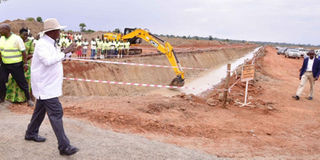Tochi Irrigation Scheme sprinkles hope to farmers

President Museveni officiates at the ground breaking ceremony of Tochi Irrigation Scheme in Myene Sub-county, Oyam District in August. FILE PHOTO
Oyam- More than 1,000 households are set to benefit from the Sh28.3 billion Tochi Irrigation Scheme in Myene Sub-county in Oyam District.
The five-year project that was launched in 2016, is funded by the African Development Bank, Nordic Development Fund and the government of Uganda.
According to the Oyam District chairman, Mr Nelson Adea Akar, the construction period is estimated to last two years.
“Since we are encouraging fish farming under the project, it will increase the fish supply in the market, thereby reducing prices of fish and making it affordable to many households in Lango sub-region,” Mr Adea told Daily Monitor in an interview on Sunday.
Fish prices
Currently, the price of a relatively small tilapia fish is Shs5,000 compared to Shs1,000 two years ago, while a bigger tilapia fish costs up to Shs30,000.
This makes fish a luxury, especially for the poor.
Mr Adea further said the project will also create jobs for the several jobless youth since fish farmers will employ a number of people to work in their fish ponds.
He added that plans are underway to construct a hatchery at the scheme to boost fish farming and increase the multiplication of fish in northern Uganda.
“We want to transform the agricultural sector by exposing farmers to new technologies,” he added.
The objective of Tochi Irrigation Scheme is to improve farmers’ income, rural livelihoods, food security and adaptation to climate change through sustainable natural resources management and agriculture enterprise development.
According to the ministry of Water and Environment, the scheme has a water reservoir with a capacity to hold 10 billion litres of water sufficient to cover a dry period of about five months.
Mr John Magezi Ndamira, the national project coordinator for Farm Income Enhancement and Forest Conservation Project, said the production of rice and other horticulture produce such as chili, green pepper and cabbages will be promoted on the scheme.
“Irrigation is quite an intensive activity so we expect that the 500 hectares will be distributed among 1,000 households, with each household getting half a hectare. That is about 1.25 acres,” he said.
The national project coordinator for Farm Income Enhancement and Forest Conservation Project said the scheme has three areas of intervention, including agriculture infrastructure (irrigation), agribusiness development and natural resources management.
President Museveni, while officiating at the ground-breaking ceremony of the scheme last month, asked residents to embrace farming once the project is completed to attract buyers.
He also noted that the irrigation would encourage production of more diverse foods for household consumption.
Many farmers countrywide depend entirely on rain-fed agriculture despite high rainfall unpredictability.
Between 2016 and 2017, Lira Metrology Centre received a total amount of rainfall of 1278 millimetres, which was the highest in the country but below the national average rainfall for the year, according to Uganda Meteorological Authority. This unreliability and ineffectiveness of rainfall in the country greatly affected farmers right from the planning time through planting, maintaining, harvesting, storing and marketing of their produce.
Other schemes
Nonetheless, the government, with support from development partners, is currently constructing five irrigation schemes in Pakwach, Kwen, Butaleja, Oyam and Kasese districts.
The schemes are supposed to raise agricultural productivity levels thus achieving food security in the beneficiary areas.
The coordinator for agriculture infrastructural development, Mr Ronald Kasozi, said the government selected the schemes based on “technical, economic, social and environment criterions”.
“Under technical criteria, we looked at water availability and the nature of technology because we focus on gravity-based irrigation system; we looked at crop production potential, among others,” he added.




